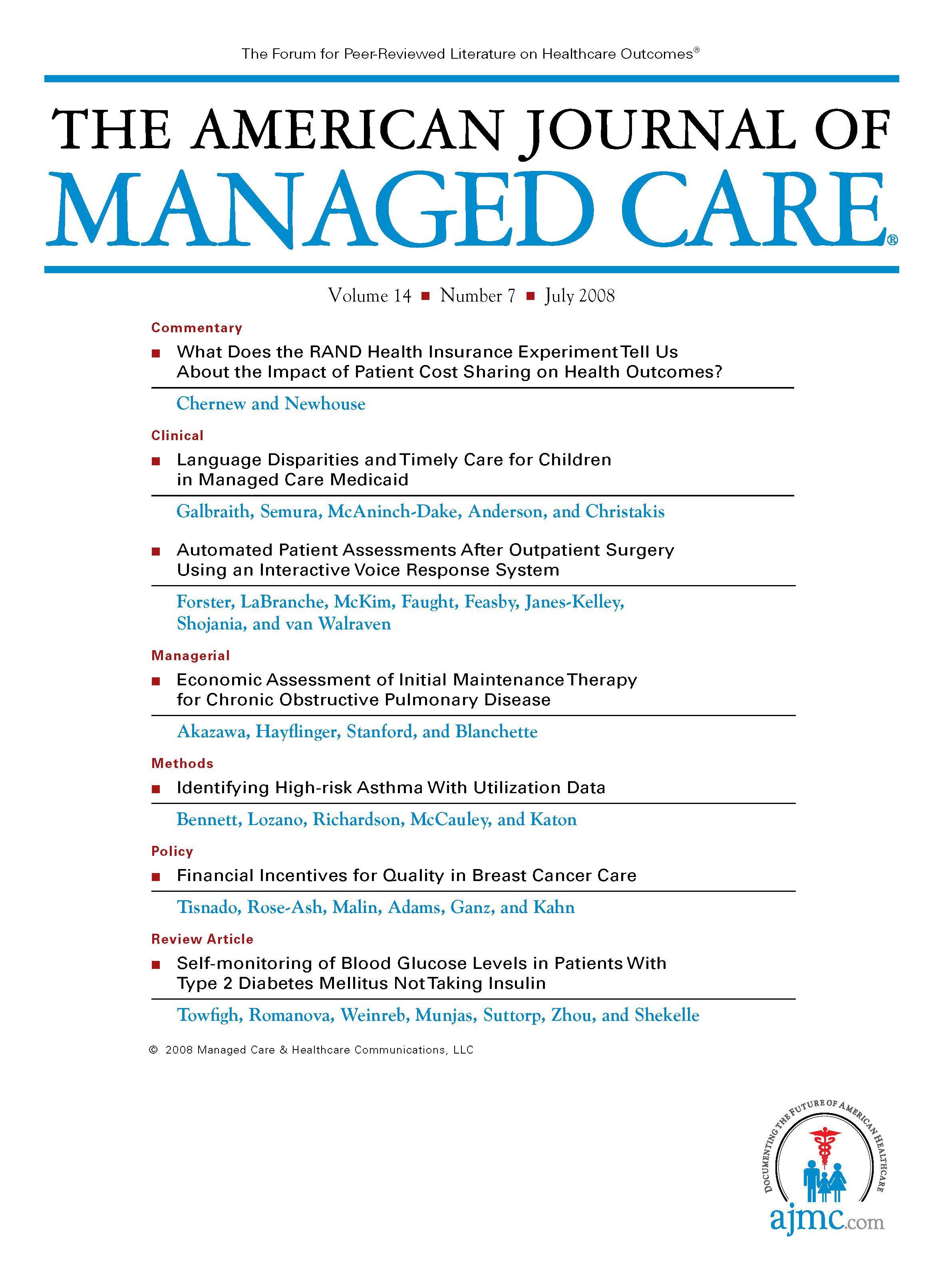- Center on Health Equity & Access
- Clinical
- Health Care Cost
- Health Care Delivery
- Insurance
- Policy
- Technology
- Value-Based Care
Controlling Adverse Drug Reactions Through Improved Monitoring
The annual cost of drug-related morbidity andmortality in the United States has been estimatedat more than $136 billion.1 Adverse drug reactions(ADRs) contribute significantly to these costs.2Epidemiological studies indicate that ADRs occur in 5%to 20% of all hospitalized patients,3,4 and that 3% to 28%of all hospital admissions may be drug related.5-10
Adverse drug reactions and therapeutic failures canbe considered subsets of adverse drug outcomes. Whenmedication errors cause adverse drug outcomes, thefocus tends to be on errors of commission (ie, mistakesin prescribing, dispensing, and/or administration ofdrugs). For example, dispensing errors occur whendrugs have similar names (spelled or pronounced alike),or when a misplaced decimal point results in the wrongdosage. Medication errors, however, also can be errors ofomission. Errors of omission leading to ADRs or therapeuticfailures have been reported to include11:
- Drugs considered to be inappropriate for thepatient's condition (ie, because of contraindications,comorbid disease states, or dose adjustmentsfor renal insufficiency).
- Dosage or frequency of administration consideredinappropriate for the patient's condition.
- Previous history of an allergy or adverse reactionto the drug.
- Drug interactions.
- Poor patient compliance.
- Incomplete or inadequate monitoring of drugtherapy.
An ADR or therapeutic drug failure involving 1 of theabove factors is considered to be preventable (ie, a medicalerror). The adverse outcome could have been avoidedif optimal medical care and monitoring had beenprovided.
The article by Raebel et al focuses on 1 of the leadingcauses of preventable adverse drug outcomes—lack oftherapeutic drug monitoring. In this epidemiological,retrospective review, Raebel et al report on a cohort ofambulatory patients whose therapy included drugs withnarrow therapeutic indices. Due to a direct concentration-effect relationship, these drugs provide therapeuticbenefits within a narrow range of concentrations. Belowthat range, therapeutic failure can occur. Above thatrange, serious ADRs can occur. Therapeutic drug monitoring,especially with patients who seem to be more atrisk, may prevent adverse drug outcomes on both endsof the drug-concentration relationship.
As a pharmacist educator and clinician focusing onthe identification, preventability, and analysis of ADRs,I create an annual "top 10" list of drugs that lead to hospitaladmissions at my practice site. It is always interestingto see that just 10 drugs cause 40% to 60% of allADRs. Drugs on these lists (eg, warfarin, digoxin, phenytoin)often have narrow therapeutic indices. Such drugsrequire laboratory tests to determine the direct concentration-effect relationship. In nearly every case of hospitalization,patients taking these drugs had toxic bloodlevels. Had more adequate therapeutic drug monitoringbeen performed, many of these hospitalizations mighthave been avoided.
Raebel et al report a lack of therapeutic drugmonitoring involving certain drugs and certain patientpopulations (eg, elderly, children). Fifty percent or moreof patients receiving drugs such as digoxin, theophylline,procainamide, quinidine, or primidone did nothave therapeutic drug monitoring tests that would indicatethe plasma concentrations of these agents.Although clinical implications (ie, hospitalizations,emergency department and/or physician visits) werenot evaluated, this study does show that inadequatemonitoring of drugs with narrow therapeutic indices is asubstantial problem. This report may increase awarenessamong physicians, pharmacists, and other clinicians, and encourage them to be more vigilant in monitoringpatients who take these agents as part of theirdrug therapy.
From Temple University School of Pharmacy, Philadelphia, Pa.
Address correspondence to: Patrick J. McDonnell, PharmD, Associate Professor ofClinical Pharmacy, Temple University School of Pharmacy, 3307 North Broad Street,Philadelphia, PA 19140. Email: patrick.mcdonnell@temple.edu.
Arch Intern Med.
1. Johnson JA. Bootman JL. Drug-related morbidity and mortality: a cost of illnessmodel. 1995;155:1949-1956.
JAMA.
2. Drug-induced illness [letter]. 1974;229:1043-1044.
J Am Geriatr Soc.
3. Colt HG, Shapiro AP. Drug-induced illness as a cause for admission to a communityhospital. 1998;37:323-326.
Arch Intern Med.
4. Lakshmanan MC, Hershey CO, Breslau D. Hospital admissions caused by iatrogenicdisease. 1986;146:1931-1934.
JAMA.
5. Caranasos GJ, Stewart RB, Cluff LE. Drug-induced illness leading to hospitalization.1994;228:713-717.
Arch Intern Med.
6. Miller RR. Hospital admissions due to adverse drug reactions. A report from theBoston Collaborative Drug Surveillance Program. AED Prevention Study Group.1974;134:219-223.
JAMA.
7. Bates DW, Cullen DJ, Laird N, et al. Incidence of adverse drug events andpotential adverse drug events—implications for prevention. 1995;274:29-34.
J Allergy Clin
Immunol.
8. Jick H. Adverse drug reactions: the magnitude of the problem. 1984;74:555-557.
Med J Aust.
9. Dartnell JG, Anderson RP, Chohan V. Hospitalisation for adverse events relatedto drug therapy: incidence, avoidability, and costs. 1996;164:659-662.
Ann Pharmacother.
10. McDonnell PJ, Jacobs MR. Hospital admissions resulting from preventableadverse drug reactions. 2002;36:1331-1336.
Hosp Pharm.
11. Schumock GT, Thornton JP. Focusing on preventability of adverse drug reactions.1992;27:538.
Am J Manag Care.
12. Raebel MA, Carroll NM, Andrade SE, et al. Monitoring of drugs with narrowtherapeutic range in ambulatory care. 2006;12:268-274.

Trends in Hospital Pricing for Vulnerable Emergency Department Users, 2021-2023
December 4th 2025Self-pay emergency department prices rose significantly from 2021 to 2023, especially at for-profit and system-affiliated hospitals, highlighting growing affordability challenges for uninsured and underinsured patients.
Read More
Integrated Care for Chronic Conditions: A Randomized Care Management Trial
December 3rd 2025The authors sought to understand the differential impact of payer-led community-based care management approaches on stakeholder-oriented outcomes for publicly insured adults with multiple chronic conditions.
Read More

